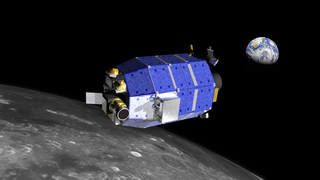Sun
Planets and Moons
ID: 13315
When a stream of charged particles known as the solar wind careens into the Moon’s surface at nearly 280 miles per second (450 kilometers per second), it enriches the Moon’s surface in ingredients that could make water, NASA scientists have found.
In this experiment, planetary scientists Jason McLain and William Farrell, from NASA’s Goddard Space Flight Center in Greenbelt, Maryland, are testing how this process works and the chemical signatures it leaves behind, which can be detected by remote sensing or surface instruments.
Using an ion gun at Goddard’s Radiation Effects Facility, scientists generate simulated solar wind and shoot it at a disc loaded with regolith inside a vacuum chamber. Then, they watch the chemistry that unfolds. By doing experiments like these, NASA scientists have found that as the Sun streams protons to the Moon, those particles interact with electrons in the lunar surface, making hydrogen (H) atoms. These atoms then migrate through the surface and latch onto the abundant oxygen (O) atoms bound in the silica (SiO2) and other oxygen-bearing molecules that make up regolith. Together, hydrogen and oxygen make the molecule hydroxyl (OH), a component of water, or H2O.
See more here: NASA Scientists Show How Ingredients for Water Could be Made on Surface of Moon, a 'Chemical Factory'
Apollo Moon Soil Radiation Experiment
In this experiment, planetary scientists Jason McLain and William Farrell, from NASA’s Goddard Space Flight Center in Greenbelt, Maryland, are testing how this process works and the chemical signatures it leaves behind, which can be detected by remote sensing or surface instruments.
Using an ion gun at Goddard’s Radiation Effects Facility, scientists generate simulated solar wind and shoot it at a disc loaded with regolith inside a vacuum chamber. Then, they watch the chemistry that unfolds. By doing experiments like these, NASA scientists have found that as the Sun streams protons to the Moon, those particles interact with electrons in the lunar surface, making hydrogen (H) atoms. These atoms then migrate through the surface and latch onto the abundant oxygen (O) atoms bound in the silica (SiO2) and other oxygen-bearing molecules that make up regolith. Together, hydrogen and oxygen make the molecule hydroxyl (OH), a component of water, or H2O.
See more here: NASA Scientists Show How Ingredients for Water Could be Made on Surface of Moon, a 'Chemical Factory'
Related
Credits
James Tralie (ADNET Systems, Inc.):
Lead Producer
Lead Videographer
Lead Video Editor
Lonnie Shekhtman (ADNET Systems, Inc.):
Producer
Writer
Jason McLain (University of Maryland, College Park):
Scientist
William Farrell (NASA/GSFC):
Scientist
Aaron E. Lepsch (ADNET Systems, Inc.):
Technical Support
Lead Producer
Lead Videographer
Lead Video Editor
Lonnie Shekhtman (ADNET Systems, Inc.):
Producer
Writer
Jason McLain (University of Maryland, College Park):
Scientist
William Farrell (NASA/GSFC):
Scientist
Aaron E. Lepsch (ADNET Systems, Inc.):
Technical Support
Please give credit for this item to:
NASA's Goddard Space Flight Center
NASA's Goddard Space Flight Center
Short URL to share this page:
https://svs.gsfc.nasa.gov/13315
Keywords:
SVS >> HDTV
SVS >> Moon
SVS >> Radiation
SVS >> Solar Wind
SVS >> Space Weather
SVS >> Heliophysics
SVS >> Apollo Missions
NASA Science >> Sun
NASA Science >> Planets and Moons
SVS >> Sample Return
https://svs.gsfc.nasa.gov/13315
Keywords:
SVS >> HDTV
SVS >> Moon
SVS >> Radiation
SVS >> Solar Wind
SVS >> Space Weather
SVS >> Heliophysics
SVS >> Apollo Missions
NASA Science >> Sun
NASA Science >> Planets and Moons
SVS >> Sample Return












